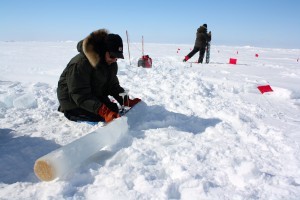Our team spent most of Friday on the Arctic sea ice, drilling and sampling ice cores at our main field site. For each core collected, Lamont-Doherty Earth Observatory scientists Andy Juhl and Craig Aumack take a number of different physical, chemical and biological measurements that characterize the ice and the organisms living inside it. Some of these measurements are recorded right away in the field, others will be taken later using pieces of the cores that we bring back to the lab.
Two of the physical measurements Andy and Craig record are the temperature and salinity of the ice. “Temperature is a critical parameter that controls the rate of almost all biological processes in the ice — almost everything happens slower when it’s colder, and parts of the ice can be colder than others. And if you know the temperature and the bulk salinity of the ice you can calculate how much brine volume there is within a given layer in the ice,” Andy explained.
Brine volume is an important measurement because algae live in brine channels in the ice. As ice gets colder, there’s less brine volume within it, meaning there’s less room for algae to grow. Andy and Craig also measure the concentrations of plant nutrients in the ice cores, including nitrate, ammonia, phosphate and silicate – some of the same elements that plants growing on land need. And, as with terrestrial plants, nutrient availability in sea ice is a factor that controls the growth of algae inside the ice.


